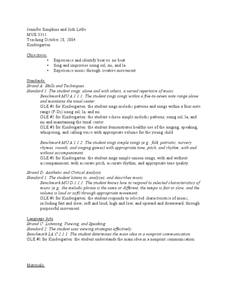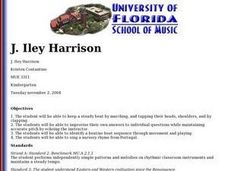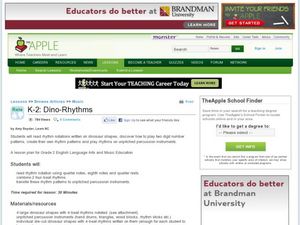Curated OER
Exploring Number Patterns to Discover Common Factors
Students listen and watch a video to see a drummer beat and find a pattern, while learning about the least common factor. In this lesson, the concept of least common factors is being taught through the use of musical instruments, and...
Poetry4kids
Rhythm in Poetry: The Basics
What makes a great poem sound so good? Learn the rhythmic secrets of poetry with an explanatory online lesson.
Curated OER
Investigation - Patterns/Functions
Learners explore one-to-one correspondence. Through activities, students examine rhythm and patterns. From the patterns discovered, learners create a visual representation of the pattern with blocks.
Curated OER
Line and Pattern
Young scholars create a silhouette of a simple figure and repeat it to create a pattern drawing with rhythm.
Berklee College of Music
Create Your Own Afro-Latin Groove
The backbone of Latin American music is the beat! Young musicians work on blending Afro-Latin rhythms and beat patterns before incorporating the major pentatonic, minor pentatonic, and blues scales in their own compositions.
Curated OER
Singing: "I Mailed Myself to You"
Keeping a steady beat, singing soft, loud, and in unison - sounds like music class to me! First graders practice these skills while listening to the song, "I Mailed Myself to You" for Valentine's Day. This is a simple and age appropriate...
Curated OER
Singing: Mi, So, La
Little ones learn the tones mi, so, and la by singing an answer to a sung question. They play a name game to identify beat, then discuss songs with no beat. If there is time during this musical instruction lesson, they dance about the...
Curated OER
Beat the Heat
Review common digraphs with your early elementary schoolers. They identify the digraph /ea/ in written and spoken language. After a brief discussion, they apply the rule for identifying and spelling words containing the /ea/ digraph....
North Carolina Standard Curriculum
Rhythm Counting
Understanding time signatures and rhythm counting are two very important parts of playing an instrument well. Here are three basic lessons rolled into one that prompt upper graders to play their instruments with care. They'll practice...
PBS
Math with Jake: Ratios and Fractions
And the beat goes on. The installment of the Math at the Core: Ratios series introduces time signatures in music. A musician shows the relationship between different types of musical beats. Working in pairs, classmates create beat...
Curated OER
Beat Or No Beat
Students keep a steady beat by body movement exercises, improvise, identify a beat/no beat sequence and sing a nursery rhyme from Portugal in this Kindergarten General Music lesson. The use of simple rhythmic instruments is required.
Midwest Clinic
Latin Rhythms: Mystery Unraveled
There is an indescrible energy to Latin American music—but if you know your music theory, it's not so indescrible after all. A thorough packet provides definitions for terms like bolero, charanga, shekere, and tumbao before listing...
Curated OER
Using Poetry As Inspiration for Composition
A reading of Robert Frost’s "The Road Not Taken" launches an interdisciplinary study of the connection between the meters of a poem and a melody. After identifying the number of beats in each line of the poem, young musicians use...
Curated OER
Introduction to musical reading for Drumset and Percussion.
Students analyze the functions of musical scores as they relate to percussion instruments. They follow an audio and video presentation as they count and follow beat patterns.
Curated OER
Reading Basic Music Notes
First graders develop skills in reading music notes. In this reading music instructional activity, 1st graders clap and chant rhythm patterns and learn music vocabulary. Students also match patterns by listening to the teacher perform...
Curated OER
Rhythm in Motion
Any age of elementary student can demonstrate their understanding of the connections of elements of art and music by creating their own slit song. You will investigate and study the Melanesian Slit Song with Kindergartners through Junior...
Curated OER
Rhythm Jam
Groups create, memorize, and perform for the class a 4 beats per measure rhythm pattern using percussion instruments including xylophones, rhythm sticks, and drums. The pattern is recorded on the worksheet provided in the resource.
Fun Music Company
Treasure Island Clues: Rhythm
Designed for rhythm level 1, the two games in this packet ask young musicians to identify the number of beats represented by a series of notes and notations, and then to use those numbers to answer a music trivia question.
Curated OER
Native American Music and Dance Activity
Students demonstrate keeping steady beat through practice exercises and stepping to the beat using instruments such as conga drums, tambourines and rhythm sticks.
Curated OER
"Viennese Musical Clock"
Fourth graders learn about musical patterns as they play a game called fudge. Students are assessed based on whether they were able to identify and play a steady beat, use the appropriate form, and clap the rythmic patterns.
Curated OER
Syncopation and Rhythm in Igor Stravinsky's Rite of Spring and Rap Music
Students recognize and clap the syncopated rhythmic beat of a rap song and identify recurring rhythmic pattern in the excerpt of "Dance of the Adolescents" from Igor Stravinsky's Rite of Spring.
Curated OER
K-2: Dino-Rhythms
Second graders read rhythm notation and combine four-beat rhythms. In this rhythms lesson plan, 2nd graders read quarter notes, eighth notes, and quarter rests in rhythms that are written on dinosaur shapes. They clap, snap, or stamp out...
Curated OER
The Beat of the Blues
This lesson focuses on how students can learn basic blues percussion patterns by considering the polyrhythms of African drumming and investigating how and why such drums were banned during slavery. Students will listen to several blues...
Curated OER
Butterflies Fly!
Chopin was a lovely composer who played the piano masterfully. Third graders are introduced to Chopin, his piano sounds, triple meter, music patterns, movement, and the waltz. They listen to his music while hearing the story Butterflies...

























